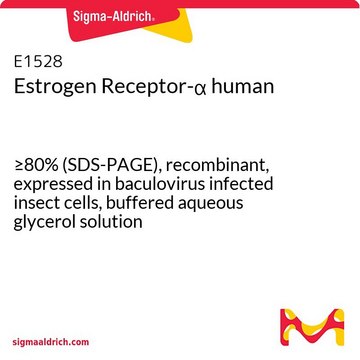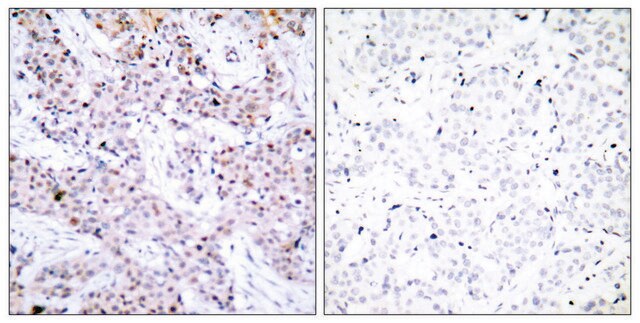일반 설명
We are committed to bringing you greener alternative products, which adhere to one or more of The 12 Principles of Green Chemistry.This antibody is Preservative-free, produced without the harm or sacrifice of animals and exceptionally stable to allow for ambient shipping and storage if needed and thus aligns with "Waste Prevention", "Designing Safer Chemicals" and "Design for Energy Efficiency".
Click here for more information.
ZooMAb® antibodies represent an entirely new generation of recombinant monoclonal antibodies.Each ZooMAb® antibody is manufactured using our proprietary recombinant expression system, purified to homogeneity, and precisely dispensed to produce robust and highly reproducible lot-to-lot consistency. Only top-performing clones are released for use by researchers. Each antibody is validated for high specificity and affinity across multiple applications, including its most commonly used application. ZooMAb® antibodies are reliably available and ready to ship when you need them.
특이성
Clone 1D2 is a ZooMAb® Rabbit recombinant monoclonal antibody that specifically detects Progesterone receptor. It targets an epitope within 21 amino acids from the internal region. Detects isoforms 1 and 2.
면역원
KLH-conjugated linear peptide corresponding to 21 amino acids from the internal region of human Progesterone receptor.
애플리케이션
Quality Control Testing
Evaluated by Western Blotting in T47D cell lysate.
Western Blotting Analysis: A 1:1,000 dilution of this antibody detected Progesterone Receptor in T47D cell lysate.
Tested Applications
Immunocytochemistry Analysis: A 1:1,000 dilution from a representative lot detected Progesterone Receptor in MCF-7 cells.
Immunohistochemistry (Paraffin) Analysis: A 1:100 dilution from a representative lot detected Progesterone Receptor in Human fallopian tube tissue sections.
Affinity Binding Assay: A representative lot of this antibody bound Progesterone Receptor peptide A-B with a KD of 1.0 x 10-12 in an affinity binding assay.
Note: Actual optimal working dilutions must be determined by end user as specimens, and experimental conditions may vary with the end user.
표적 설명
Progesterone receptor (UniProt: P06401; also known as PR, Nuclear receptor subfamily 3 group C member 3) is encoded by the PGR (also known as PR, NR3C3) gene (Gene ID: 5241) in human. Progesterone receptor, a member of the superfamily of steroid receptors, mediates the action of progesterone on its target tissues. Two major isoforms of progesterone receptor, known as progesterone receptor A (PR-A) and PR-B, have been described. They are structurally related, but functionally distinct proteins, produced by transcription from alternative estrogen-inducible promoters and alternate translational sites within a single PR gene. Depending on the isoform, progesterone receptor may function as transcriptional activator or repressor. In reproductive tissues the expression of isoform A and B varies as a consequence of developmental and hormonal status. Both isoforms are expressed in comparable amounts in the uterine glandular epithelium during the proliferative phase of the menstrual cycle. However, the expression of isoform B persists in the glands during mid-secretory phase. In the stroma, isoform A is the predominant form throughout the cycle. Progesterone receptor is phosphorylated on multiple serine residues in a hormone-dependent manner. Phosphorylation on serine 294 that occurs preferentially on isoform B is highly hormone-dependent and modulates ubiquitination and sumoylation on lysine 388. Phosphorylation on serine 102 and 345 is also hormone dependent. Basal phosphorylation on serine residues 81, 162, 190, and 400 is also increased in response to progesterone and can be phosphorylated in vitro by the Cdk2-A1 complex. Phosphorylation at serine 162 and 294, but not at 190, is impaired during the G2/M phase of the cell cycle. This ZooMAb® recombinant monoclonal antibody, generated by our propriety technology, offers significantly enhanced specificity, affinity, reproducibility, and stability over conventional monoclonals. (Ref.: Pierson-Mullany, LK., and Lange, CA. (2004). Mol. Cell Biol. 24(24); 10542-10557; Clemm, DL., et al. (2000). Mol. Endocrinol. 14(1); 52-65; Giangrande, PH., et al. (2000). Mol. Cell Biol. 20(9); 3102-3115).
물리적 형태
Purified recombinant rabbit monoclonal antibody IgG, lyophilized in PBS with 5% Trehalose, normal appearance a coarse or translucent resin. The PBS/trehalose components in the ZooMAb formulation can have the appearance of a semi-solid (bead like gel) after lyophilization. This is a normal phenomenon. Please follow the recommended reconstitution procedure in the data sheet to dissolve the semi-solid, bead-like, gel-appearing material. The resulting antibody solution is completely stable and functional as proven by full functional testing. Contains no biocide or preservatives, such as azide, or any animal by-products. Larger pack sizes provided as multiples of 25 μL.
재구성
300 μg/mL after reconstitution at 25 μL per vial. Please refer to guidance on suggested starting dilutions and/or titers per application and sample type.
저장 및 안정성
Recommend storage of lyophilized product at 2-8°C; Before reconstitution, micro-centrifuge vials briefly to spin down material to bottom of the vial; Reconstitute each vial by adding 25 μL of filtered lab grade water or PBS; Reconstituted antibodies can be stored at 2-8°C, or -20°C for long term storage. Avoid repeated freeze-thaws.
법적 정보
ZooMAb is a registered trademark of Merck KGaA, Darmstadt, Germany
면책조항
Unless otherwise stated in our catalog or other company documentation accompanying the product(s), our products are intended for research use only and are not to be used for any other purpose, which includes but is not limited to, unauthorized commercial uses, in vitro diagnostic uses, ex vivo or in vivo therapeutic uses or any type of consumption or application to humans or animals.






